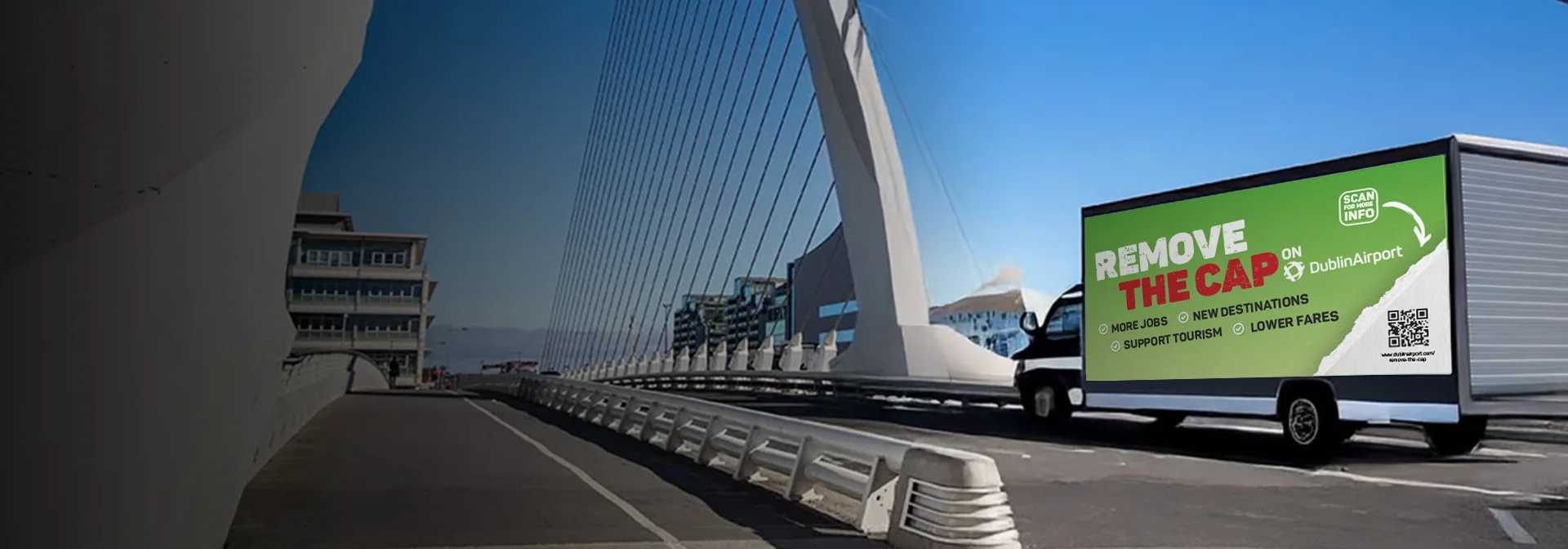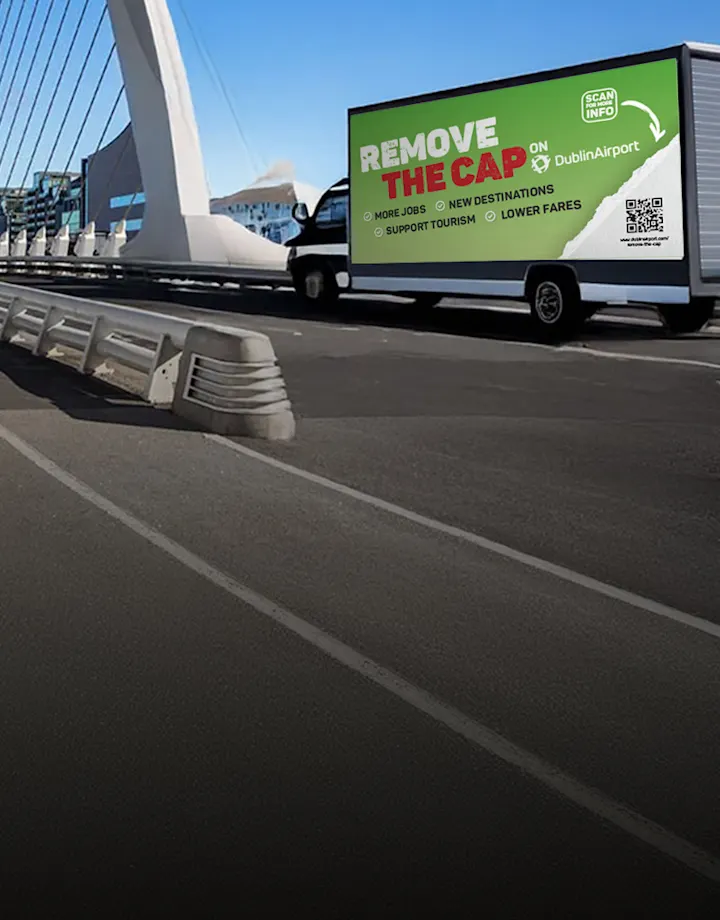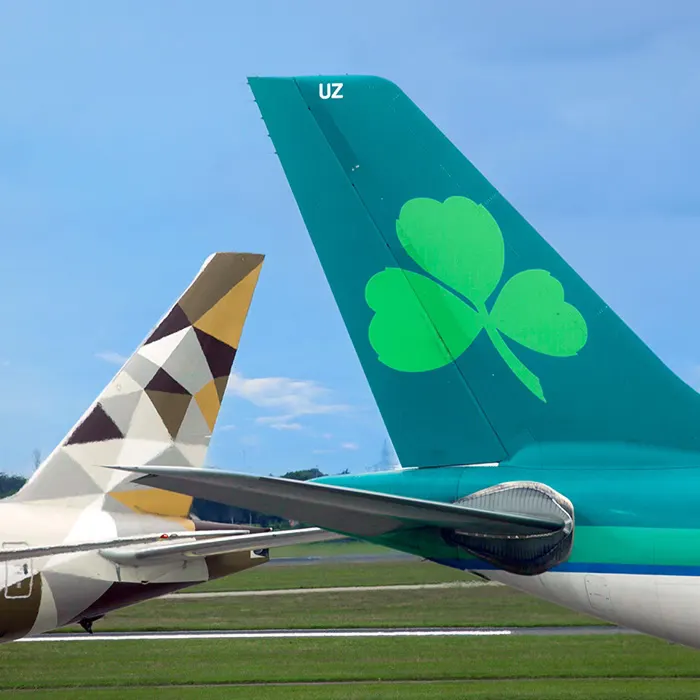

What Is The Dublin Airport Passenger Cap?
The cap is a limit on the number of passengers allowed to enter the airport’s two terminals. The cap is set at 32 million passengers per year and is a condition of the planning permission granted for the construction of Terminal 2 in 2007.
A main reason the cap was put in place was to limit traffic pressure on the access road infrastructure at Dublin Airport. Today, around a third of all passengers come to the airport by bus and the improved road network means the traffic concerns have abated.
Growing Dublin Airport to 40 million passengers a year is in line with national aviation policy, the National Planning Framework, the Fingal Development Plan and the Dublin Airport Local Area Plan. But the artificial restriction on passenger numbers entering the terminals remains in place unless removed by legislation or planning. This has serious impacts for our island nation’s economy, tourism, jobs and connectivity with the world.
This needs to change – it’s time to remove the cap.
What Are The Benefits Of Removing The Cap?

More Jobs And Economic Benefits
The economic impact of Dublin Airport - Ireland’s gateway to the world - is huge (InterVistas):
€9.6bn in Gross Value Added - equivalent to 2.3% of national GDP
19,900 direct jobs at the airport and airport-related businesses
116,100 total jobs, including indirect and catalytic effects
Industry research shows that every additional one million passengers results in 750 new aviation jobs (ACI Europe). As a small, open, island economy, our connectivity to the world is a key driver of foreign direct investment. An artificial restraint on our national hub airport undermines all efforts to attract new investment to our shores. It’s time to remove the cap.

Better Connectivity To The World
There is significant unmet demand for direct connections to Ireland. In 2024:
140k passengers travelled indirectly between Ireland and Brazil
300k between Ireland and India
97k between Ireland and Thailand
131k between Ireland and China and Hong Kong
We want to have direct services to all of these points to meet demand. Ireland has a hard-earned reputation as a global aviation leader, we can and must do better. We need to be thinking long term and at least 25-years out. With our rapidly growing population, we need to be planning for a 50 million Dublin Airport and beyond. Let’s get ahead of our infrastructure needs – as Dublin Airport did when building North Runway – and stop playing catchup. It’s time to remove the cap.

Lower Fares
Aviation is a demand-lead industry. Fewer flights and higher demand mean higher fares.
In Winter 2024/5 (Nov – Mar), when the Irish Aviation Authority cut the slots available to airlines due to the passenger cap, fares increased by 6% (RDC Apex). Industry research also shows the more congested an airport becomes, the higher airfares tend to be (ACI Europe). It’s time to remove the cap.

Supports Tourism
Tourism is Ireland’s largest indigenous industry and is worth over €10 billion to the economy. It is Ireland’s biggest regional employer, employing one in nine. It generates Exchequer receipts in excess of €2 billion (ITIC).
In Q1 2025, when the Irish Aviation Authority cut the slots available to airlines for the winter season due to the passenger cap, the impact on tourism was immediate. Passenger traffic to Ireland declined by -0.5% in Q1 2025, while airports in Europe combined saw passenger traffic increase by an average of 4% (ACI Europe).
CSO figures also recorded a significant drop in passengers to Ireland in Q1 2025 and a corresponding drop in visitor spend. It’s time to remove the cap.
How The Irish Planning System Affects Dublin Airport?
Ireland’s need for a faster and more joined-up approach to planning critical national infrastructure is well known. Dublin Airport’s development is often delayed by the slow planning process, with applications taking years to move through the system.
Decisions about Dublin Airport begin at local level with Fingal County Council (FCC). The Aircraft Noise Competent Authority (ANCA) also reviews every application to assess if a noise assessment is needed. If an appeal is made, the matter progresses to the national level with An Coimisiún Pleanála (ACP). In addition, Dublin Airport must comply with Irish and EU aviation regulations, including EU aircraft slot coordination, and international agreements such as the EU–US Open Skies agreement.
Recently, Ireland’s High Court acknowledged the complexity of Dublin Airport’s efforts to comply with multiple, and sometimes conflicting, rules and regulations. The Court has referred the matter to the European Court of Justice for guidance—a process that may take up to two years.
In the meantime, reclassifying Dublin Airport as strategic national infrastructure would help. This change would allow planning decisions that do not involve noise issues to go directly to ACP, helping to streamline the process.

A Note From Our CEO
“Our small island nation has a proud history as an aviation leader, and our connectivity with the world is vital for our economic prosperity. Ireland’s growing population and global demand to travel here means Dublin Airport’s passenger numbers will be north of 36 million this year and heading towards 40 million before the end of the decade. As our global gateway to the world and Ireland’s only hub airport, Dublin Airport is also vital strategic infrastructure. While the passenger cap remains in place, our national airport is hamstrung and daa can’t progress its mandate to grow Ireland’s connectivity on behalf of the Irish state. The cap at Dublin Airport needs to be removed once and for all, and the airport needs to be reclassified as national strategic infrastructure, with decisions made by a national planning body. Our government has recognised the importance of the issue and has committed to resolving the cap problem – this can’t happen soon enough. We urge the Minister to publish the proposed solution asap. It’s time to remove the cap.”
Kenny Jacobs, daa CEO
In December 2023, daa, the operator of Dublin Airport, submitted what is known as an “Infrastructure Application” (IA) to Fingal County Council (FCC). The IA looked for permission for a range of significant investments in critical infrastructure and sustainability improvements at Dublin Airport. It also sought permission to increase the annual number of passengers to 40 million, which is in line with national aviation policy, the Fingal Development Plan and the Dublin Airport Local Area Plan.
The IA responds to the unequivocal national demand for air travel and daa’s role on behalf of the Irish state to manage and sustainably develop Dublin Airport in the national interest. However, its progress has been stalled due to Ireland’s slow and difficult planning system.
FCC says it can’t progress the IA until the noise regulator, known as ANCA, gets information it has asked daa for. But daa can’t provide that information until An Coimisiún Pleanála (ACP) makes a final decision on a different planning application regarding the hours of operation of Dublin Airport’s North Runway and the proposal to manage nighttime noise at the airport through an annual noise quota.
FCC and ANCA decided on this back in 2022 but it was appealed to ACP, and three years on we are still waiting on a final decision. This has had severe knock-on implications for other daa planning applications, particularly the IA.
To try resolve the impasse, in December 2024 daa lodged what is known as a ‘no build’ Operational Application (OA), which looked for permission to increase the passenger cap to 36 million while daa waited for the IA to be approved. But this has also hit a wall due to the ACP decision not yet being made.
Planning in Ireland is like a game of snakes and ladders; we need more joined-up thinking to cut through these blockages and allow Ireland to get on with building the infrastructure we need for our future.
Thankfully, the government understands the urgent need to tackle the passenger cap issue and has committed to doing all it can to resolve it. Minister for Transport Darragh O’Brien confirmed in May he expects to bring forward a legislative solution in the coming months, while respecting the independence of the planning process. In June, he stated that he wanted to see the cap removed and that any artificial stifling of growth at Dublin Airport would be counterproductive for the country. This is the kind of leadership we need; we urge the Minister to publish the proposed solution asap.
We can wait no longer to resolve the passenger cap issue: it’s time to remove the cap.
We have tried and exhausted all legal and planning options possible to dampen passenger and airline demand. But Dublin Airport does not have the power to prevent planes from landing or passengers from boarding them – and would be acting illegally if it tried. The Irish Aviation Regulator (IAA) does have this power as it allocates slots to airlines twice a year for the summer and winter seasons. The IAA took the cap into account when allocating slots for Winter 2024/25, which had a clear impact on Ireland’s connectivity:
Q1 2025 EU aviation data: Ireland seat capacity predicted to shrink -3.3% vs +6.5% average increase.
Eurocontrol data Feb 25: Ireland at the bottom of the European list for seat capacity vs other European countries.
OAG Feb 25 capacity data: DUB has slipped to 16th for capacity/connectivity in Europe (normally we’d be 10th).
ACI Jan 25 European pax stats: Ireland significantly underperformed the European average due to the cap. Ireland up 1.5% up vs Jan 2024 vs European average of 6.9%.
CSO figures 2025: number of visitors to Ireland in January fell , as did their spend.
The IAA proposed more seat cuts when allocating slots for Summer 2025 but this was challenged by multiple airlines and airline representative groups in the High Court. The judge agreed that there were complex legal issues at play and asked the European Court of Justice (ECJ) to decide which takes precedence: local planning law or EU slot rules. While we wait for the ECJ decision – which could take two years - the judge has placed a stay on the IAA imposing cuts on slots until the ECJ decision comes back.
This brings temporary relief as, in effect, the stay means the planning cap is now a zombie cap as there is no restriction on the airlines getting the slots they ask for. But this doesn’t remove the cap, or Dublin Airport’s obligation to comply with it, or allow Dublin Airport to get on with building the piers and stands it needs to accommodate growth to 40 million passengers. It also doesn’t give airlines certainty when planning new routes.
This continued uncertainty about Dublin’s capacity is significantly unhelpful and a permanent resolution to the impasse is much better than ongoing planning and legal disputes. We are an island nation dependent on aviation for our connectivity and prosperity: it’s time to remove the cap.
Aviation statistics report on all arriving and departing passengers at Dublin Airport.
The cap applies to passengers entering the terminal buildings only.
There are other passengers who are not counted towards the cap, including transfer passengers (who do not leave airside), and transit passengers (those who do not get off their aircraft).
daa’s IA applies to raise the cap to a total of 40 million passengers e.g. all passengers are counted, not just terminal passengers. As daa had a total passenger number of 34.6m in 2024, and is on course to have more than 36m in 2025, the urgency of resolving the cap issue is clear: it’s time to remove the cap.
Overall, 2024 was a year of growth despite daa’s effort to dampen demand, with a total of 33.3 million passengers through the terminals, a 4% increase on 2023 numbers. Including connecting and other passengers, the total number of passengers using Dublin Airport in 2024 was 34.6 million (+3.3% vs 2023).
On 171 days in 2024, the airport managed more than 100k passengers a day, demonstrating its operational capacity to manage 36 million passengers a year. Given the strong demand for travel in and out of Dublin Airport, daa estimates that overall numbers would have been even higher had it not been for the terminal's passenger cap and daa’s initiatives to dampen demand to comply with planning.
Read more in our January media release.
Due to high passenger and airline demand for travel, Dublin Airport is on course to have more than 36 million passengers in 2025. As the High Court has placed a stay on the IAA being able to restrict airline slots, daa has no way to reduce this numbers.
The cap is outdated and must be removed asap but that’s only part of the problem. The IA must move swiftly through the planning process so that building can start before Dublin Airport runs out of capacity. If the planning system takes until 2029/30 to approve the IA and daa can only start building the necessary infrastructure then, it will be a serious scramble to build new capacity.
daa did apply to lift the cap in 2019 but was advised by FCC to withdraw it as FCC was already in pre-planning for daa’s application to lift the highly restrictive operating conditions imposed on Dublin Airport’s North Runway. daa regrets taking that advice and, in hindsight, should have followed through on previous attempts to increase the cap. But we're working within a slow and complicated planning system that is not conducive to the kind of decision-making and action that other major airports enjoy in the UK and Europe. That’s neither the fault of daa nor FCC; it’s the fault of a broken planning system that is letting Ireland down.
What’s critical now is all stakeholders working together to find a way through the impasse in the national interest, ensuring Ireland doesn't lose vital connectivity, jobs, tourism, and economic growth opportunities over the years ahead. It’s time to remove the cap.
People often think the cap is in place for sustainability reasons but that is not the case; it relates to concerns about road traffic congestion in 2007. Aviation is one of the hardest sectors to decarbonise and it is vital airports, airlines and all actors in the aviation sector play their part in the transition to net zero, But using a blunt cap to tackle this does not reduce emissions. If Ireland loses those flights, the planes and the emissions they create go elsewhere, but so do the jobs, economic impact and connectivity that goes with them. There is no carbon reduction benefit, but Ireland does lose out. We are an island nation dependent on aviation and need a better solution than sending the problem elsewhere. Growth at Dublin Airport and the concept of sustainability are not mutually exclusive, and we believe that we can manage both to address the needs of our country and our people, and the sustainability considerations required to facilitate a transition to a more sustainable model of aviation. Our sustainability ambition is driven by three principles:
Decarbonisation: Accelerating the path to Net Zero Emissions by reducing carbon emissions on the ground and in the air.
Circularity & Waste: Creating Zero Waste operations, where we minimise and reuse our wastes.
Healthy Local Environments: Create healthy local environments for the benefit of staff, passengers, and local communities, focussing on air quality, water, noise, biodiversity and positive local engagement.
Our commitments include:
We have committed to achieving the 2030 targets, set by government, in line with the Climate Action Plan of a 51% carbon reduction.
We have committed to Science Based Targets for the whole of daa group, as well as Climate Risk Scenario modelling and adaptation planning to ensure operations at our critical national infrastructure.
We will continue to invest in alternative energy sources as part of our commitment to 20% onsite renewables at our airports by 2030. See here for the latest on our solar farm ambitions.
We are working collaboratively and proactively with all stakeholders, and especially with the Department of Transport on the future of alternative fuels, notably Sustainable Aviation Fuel (SAF), and climate adaptation planning.
We are acting for a sustainable future as we are all very conscious that we have a “World to Connect and a Future to Protect”. For more see our sustainability section on our website.
There is strong support for the airport locally. Independent research carried out by Red C on behalf of daa this spring found 86% of Fingal residents support further development of Dublin Airport to allow it to grow, while 84% agree that having the airport in their community fuels economic development. Take a look at this article, Strong community backing for Dublin Airport growth confirmed by new independent research.
The primary drivers of positivity towards the airport are the employment provided by Dublin Airport and its overall impact on economic development within the community. Negativity towards the airport is due to noise and associated issues, which Dublin Airport takes very seriously. We work really hard to minimise the impact of our operations on the local community and offer a comprehensive suite of noise mitigation measures, which are kept under constant review. More details on this and our €10 million Community Fund supporting local groups and projects are here and here.
A public poll conducted by The Journal on March 31, 2025 showed strong public support for the removal of the cap. Of the more than 10,000 people who voted, 77.9% voted yes to removing the cap (8558) verses 19.1% who voted no (2093) and 334 who were unsure.
No. Some have suggested that capping Dublin Airport means regional airports benefit but there is little evidence of this.
daa is on record as supporting growth of all of Ireland’s airports and has been actively encouraging airlines to move to other Irish airports while Dublin Airport remains capped. But airlines can choose to fly wherever they want; they make decisions based on population density and ability to fill planes. If they can’t fly to Dublin, they are more likely to fly to other European cities like Glasgow and Manchester than Cork and Shannon.
Supporters of regional airports who talk about Dublin Airport being “dominant” and view handling 85pc of national traffic as a negative show little understanding of European norms. Amsterdam’s Schiphol has 87pc of national traffic in the Netherlands, Helsinki has 83pc in Finland, Copenhagen 84pc in Denmark, and Vienna handles 90pc of Austrian air traffic.
Like these other capitals, Dublin is a hub airport that can support a much higher level of connectivity by pooling both point-to-point and transfer traffic. It is the mixture of short- and long-haul flights that creates this effect.
This is crucially important to enable Ireland to compete with other European airports for routes and services. And not easily replicable by regional airports that don’t have the population density to make these flights commercially viable.
It’s understandable that people would like to have every route available at their closest airport. But attempting to duplicate routes at regional airports rather than concentrating on one hub which people have good access to is also against sustainability and efficiency principles.
There are also three international airports in Northern Ireland, so on an all-island basis Dublin Airport manages 65% of traffic.